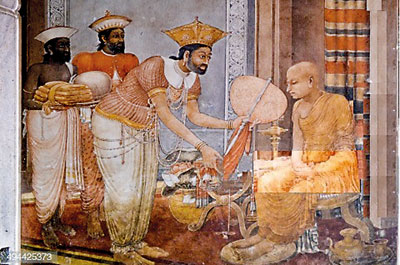Arts
The monk who led Buddhism’s revival in Ceylon
View(s):- Extracts of an article by D.T. Devendra (published in the Ceylon Observer on May 3, 1936)
The name of Weliwita Saranankara, the great Sangharaja of the 18th century is venerated by the Buddhists of Ceylon. It was due to his efforts that the Upasamapada or Ordination of the Buddhist clergy was established in the island, when the very priesthood was in danger of being completely effaced.
The material for a study of Saranankara’s life is available at the Weliwita temple in Asgiriya. The present incumbent of this temple is a pupillary and lineal descendant of Saranankara. In this temple one can see articles that belonged to him, as well as the Poyage erected on the establishment of the Upasamapada. The ceiling of the building is elaborately painted and on the walls are portraits of some priests famous in connection with Saranankara’s work.

An artist's impression of Ven. Welivita Sri Saranankara Sangaraja Thera
Saranakara was born in 1698, the year of the first Spanish Partition Treaty in European history. He was studious as a lad, and spiritually inclined. At that time however, religion had been dead, so to speak, amidst the troublous politics arising even in the Kandyan Kingdom, from the presence of the foreigner in the Low Country. When for reasons of conviction or hypocrisy, the influential men embraced the Christian faith, their example was not lost on the Kandyans, who moreover, had to fight for their very lives.
For years past, as during those days, the priesthood itself had degenerated and comprised largely of men who led much the same sort of life as led to the earlier suppression of Catholic monasteries by the Catholic Henry VIII, Defender of the Faith. The reader of Knox’s Ceylon is struck by the peculiarity in the appearance of the ‘Terunnanse’ whose long wavy beard is certainly absent from the faces of Buddhist monks. The fact is that there were really no ordained monks at the time. The picture is that of a member of asemi-priestly order known as ‘Silvats’ or the Virtuous ones. Some of these ‘Silvats’ wore the saffron robes of the samaneras or the Novices who observe the Ten Precepts only. Other ‘Silvats’ were laymen. From the absence of the Upasmapada priests could be inferred
the state of degeneracy to which Buddhism had fallen.
Saranankara’s task was to reintroduce the religion of his fathers. In the first place he had to learn Pali. There was hardly a scholar who could help him. Nevertheless he set about with such determination that he soon made himself proficient in both Sinhalese and Pali and quickly gathered round him a number of men ready to dedicate their lives to the task of their revered guru.
But the ‘Silvats’ who constituted their party were viewed with definite disfavour, especially by the influential Chapter of Malwatte. They complained to the King of this innovation (in which they feared a blow to their own prestige) and pointed out to King Narendrasingha that the ‘Silvats’ could not claim equality with the Samanera already in existence with the priesthood.
With the passage of time however, Sarananakara’s good work and gradually he came to occupy a position of unquestionable prominence. With the patronage of royalty, he organised three embassies to Siam, for the purpose of introducing Upasampada into Ceylon. Two of these were unsuccessful and cost the lives of the emissaries. The third in the reign of King Kirti Sri Rajasingha, eventually succeeded.
The Siamese envoys landed at Trincomalee and arrived in Kandy. The earliest to receive ordination was Saranankara, who was over 50 years old at the time.
Soon numbers were admitted to the priesthood and Buddhism had regained its lost hold on the lives of the clergy and laity.
Saranankara was given the high office of Sangha Raja. In his biography from which many of the facts recorded here are taken, Sir Baron Jayatilaka thus says, “ Never was honour more worthily earned, and never did royal bestowal of honour better accord with the wishes of a nation than on this occasion when King Kirti Sri Rajasingha, surrounded by his Ministers, proceeded to Malwatte Vihara and there in grand assembly of the Bhikkhus presented Saranankara with the insignia of the office of Sangha Raja. But honours made no change in his mode of life. He lived the same simple life, continuing his labours, and inspiring his pupils, by precept and example, with an enthusiastic love for unselfish work for the good of the world.”
Saranakara continued his work to the end with the same unflagging zeal and devotion. He died in his 81st year. His body was taken to the present Dalukgolle Raja MahaVihare, Ampitiya.
Saranankara’s body was cremated with the greatest of honours. The place of cremation is marked by a heap of stone through which grows an aged ‘Na’ tree. Over his ashes was built the Sangha Raja Chaitya which can be seen on the upper compound of the Pirivena.

